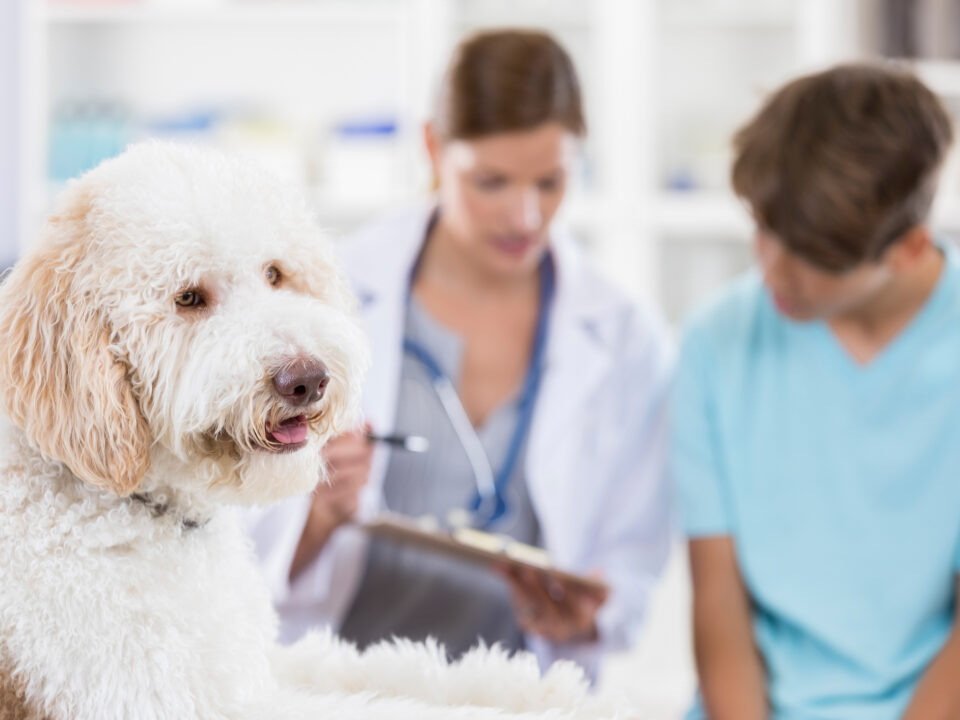Sunburn on Dogs: When to See a Vet

Reverse Sneezing in Cats: Is it Normal?
May 18, 2023
All About Paw Pad Injuries On Dogs
May 18, 2023Sunburn on Dogs: When to See a Vet
Did you know your dog can get sunburn when spending too much time in the sun, just like you? Many pet parents do not realize that their dog’s skin is sensitive to UV rays and needs sunscreen.
If your dog has a sunburn and their skin turns purple or blisters with pus, they need to see a vet. Your pup may be in serious pain, and if they are whining excessively and have a sunburn, they should be seen.
Read on to learn more about sunburn on your pup and when to see a vet.
Can Dogs Get Sunburned?
All dog breeds can get sunburned, but some pups are more susceptible than others. This includes dogs with shorter or lighter hair, and pups with fair or pink skin underneath their coat. Harmful UV rays do not take long to penetrate the skin and create a sunburn. Dogs that are more at risk for sunburn include:
- Dalmatians
- Chihuahuas
- Greyhounds
- Chinese crested
French bulldogs and Bull terriers are also more prone to sunburn. Dogs with medical conditions that may cause hair loss are more at risk for sunburn as well. This hair loss includes anything from hot spots to hormonal disorders, like alopecia, hypothyroidism, and Cushing’s.
What Are the Symptoms of Sunburn on Canines?
You should know the symptoms of sunburn on dogs so you can help them if they are demonstrating any signs. If your canine has any of the subsequent symptoms, take them to the vet as soon as feasible.
1) Skin That is Dark Pink or Red
Like a human who spends a lot of time in the sun, their skin can change color, and a dog’s skin will also turn dark pink or red if sunburned. If the skin is pink, your dog’s sunburn is mild, but if it is a deeper shade of red, it is more severe. Pink or red skin tender to the touch is one of the dogs’ first signs of sunburn. The burns can progress over the next few hours to days. Sunburn can be damaging to the skin.
2) Blisters Can Form
If the sunburn is moderate to severe, you will likely see blistering or inflammation on your pup. The blisters may eventually pop. There may be many blisters, which can have pus and may be uncomfortable or even painful for your pup. This indicates that the sunburn could be serious. If you spot any blisters on your canine, immediately take them to the vet.
3) Skin Texture Changes
The skin may become damaged if your dog has sunburn, and the nose is commonly affected. The skin is comparable in color and texture to a human being with a severe sunburn. The texture will alter, and you may detect some visible signs, such as:
- Cracking
- Dryness
- Flakiness
- Peeling
Sunburn is not often itchy, but some pups will chew and scratch at their sunburn, which can result in a secondary bacterial infection. The skin will become sensitive, and there may also be curling at the edge of their ears. Even the belly can become dry and sore.
4) Fever or Change in Body Temperature
Many dogs will run a low fever when they have sunburn. Be careful to watch for signs of heatstroke. If your dog is exposed to the sun for a long time, they may develop a high temperature of about 103 to 106 degrees Fahrenheit. If this is the case, you will have to take action fast. Safeguard your canine’s skin and health by keeping them in the shade as much as feasible.
Dog Sunburn Treatment
Dogs typically have more damage to their skin from sunburn compared to humans. For any species, prolonged exposure to the sun without adequate protection can produce a painful sunburn. You may hear your pup whine because their skin is sore. Luckily, there are ways you can treat a dog with sunburn:
Apply a Cold Compress
Apply a wet, cold towel or washcloth to the sunburned area. It will help with the inflammation that occurs with sunburn. Gently place it on the burnt site of the skin until it feels cooler to the touch.
Aloe Vera Ointment
Aloe vera helps soothe the skin and alleviate the symptoms of sunburn. It has cooling and anti-inflammatory properties. Aloe may help preserve the skin’s moisturizer and lessen skin peeling.
Coconut Oil
Coconut oil may help reduce itching and skin inflammation associated with sunburn. It is a great natural product to help protect against UV rays and provides some moisture to the skin.
Vitamin D or E Capsule
You can extract the oil of a vitamin D capsule and pat it on the sunburned skin to help inhibit scarring. It will help decrease the redness that accompanies sunburn. Vitamin E can help to repair the skin as well.
When Would I Need to Take My Dog to the Vet for Sunburn?
A dog getting sunburned is not necessarily an emergency, but there are some situations when your sunburned pup will need to see a vet. The following are indicators your canine may need to see a vet:
- When the skin looks purple
- When there are blisters and pus
- When your dog is dehydrated
- When your dog is in pain
While at the vet, they will treat the initial problem, and then you will likely need to follow up at home by cleaning the wounds and applying topical medication.
How to Avoid Sunburn in Canines
The safest remedy for sunburn is prevention. You want to avoid the situation and ensure your dog is protected. You can start by providing access to the shade and keeping your dog away from direct sunlight, which will help keep your dog from getting sunburned. You should also use dog-safe sunscreen. Never use human sunscreen on your dog, as these contain ingredients that can harm them.
Choose the highest UV protection available, and apply sunscreen to sensitive areas like the nose, near the eyes, and the belly. Try to keep your dog from licking off sunscreen if possible. Make sure you apply the sunscreen thoroughly and evenly. You can also get UV-reflective clothing to protect their belly from exposure to the sun.
Conclusion
To protect your dog from sunburn, you will need to purchase a dog-safe sunscreen, and if they do get sunburnt, use the tips in this article to help soothe your pup and ease symptoms. If the sunburn looks purple, your dog has pus blisters, or is in pain, you should take them to the vet for treatment. Remember, the best medicine for sunburn is prevention.
For pets in the North Jersey region, Pet Check Urgent Care has locations in Sewell, NJ and Deptford, NJ. Visit us online to learn more!






